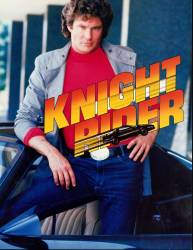Continuity mistake: When Michael picks up the locket and opens it, the way he holds it with his fingers changes in the close-up shot.
Lost Knight - S3-E10
Continuity mistake: The red wagon has Bob's plumbing painted on the side of the driver's side door.When being chased by Michael Knight, the sign is missing. It reappears later when Doug is playing inside it.
Continuity mistake: When Michael and KITT have the murdering driver cornered and get him to talk, KITT is asked to pop in a tape to record the confession. When it goes in, it's a white cassette. When Michael comes in to get Krebbs, he holds up a black cassette.
Continuity mistake: Toward the end of the episode, the convoy moves out, with KITT bringing up the rear. If you look, there's nobody in KITT's driver sear. As KITT exits the yard, Michael is suddenly there, driving as usual.
Continuity mistake: When you see Bonnie and Devon in the audience waiting for Michael and K.I.T.T to perform, sitting next to Bonnie is a guy in red shirt. In another shot of the audience the same guy can be seen sitting higher up in the seating area and sat with other people. When you next see Bonnie and Devon, the guy is back sitting next to her.






Answer: KITT didn't choose to go off the cliff in Goliath Returns, it just happened as he tried to avoid Goliath. Just 'cus it happened, doesn't mean It's gonna cure his fear of "flying"